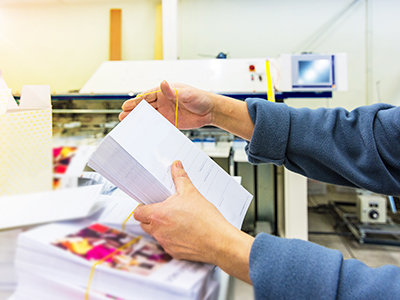What do you want to ship?
Where do you want to ship?
Packing Solutions
Business Solutions
The flyer is one of the most well-known and effective advertising tools - and has been for over 500 years! In fact, the history of the flyer goes back to the Middle Ages: as early as in 1488, in the absence of store signs, traveling merchants used flyers to advertise their range of goods or services.
Much has changed since then. The modern flyer is infinitely more multifaceted than the medieval leaflet, and it can be produced cheaply in huge numbers. Unlike back then, however, there are now a number of design and structuring rules that have crystallized over time with a view to achieving the best possible advertising impact. Anyone who wants to design a flyer for their company - or have it designed - should be familiar with these rules.
Every flyer publisher should first ask themselves two questions before launching a flyer campaign:
These two questions are so fundamental because the answers have implications for the choice of flyer format and material. For example, if the target audience is visitors to a major event and the individual flyers are not to be distributed, but rather stuck under the car windshield wipers in the parking lot outside the event site, the format does not play a major role. More important then is the material: the paper should be somewhat weather-resistant so that the flyers do not turn into colorful mush even in a light drizzle.
|
If, on the other hand, the target group is passers-by in a pedestrian zone to whom the flyer is to be pressed into the hand, then the format is more important than the paper. The flyers should then fit into a shirt breast pocket and into an inside jacket pocket (i.e. have e.g. DIN-long format) - otherwise there is a risk that the flyers will not be pocketed by the recipients, but carelessly thrown away. |
 |
If you are planning to send the flyers by post, then light paper makes sense - especially if the flyers are to be put in an envelope as part of a letter mail item together with other papers. And of course, it is then also important to ensure that the flyers have a standard postal format, for which no special postage charges are incurred.
|
For printed flyers, the "AIDA" formula applies in terms of content structure. "AIDA" stands for the English words Attention, Interest, Desire and Action (= attention, interest, desire, action). The formula specifies the order in which these points should be taken into account in a advertising material. |
 |
The first thing to do is to attract attention. The title of a flyer should therefore always stand out - be it with a strong headline, be it with an irritating image or be it with an interesting message ("New opening," "70 percent off," "Drive-in service now" or similar).
Next, the reader's interest in the actual flyer message must be aroused. Accordingly, the flyer text should be structured to address a specific problem or need of the target audience right at the beginning (for example: "Summer is just around the corner, but you don't have a bikini figure yet?"). The subsequent text must then direct the reader's interest to the company's own product or service offering.
Following this, the product or service offer must be "underpinned" with arguments, in such a way that desire is aroused in the readership. (Example: "Your advantages as a member of our fitness club: first ... second ... third.").
Finally, the most important point follows: the so-called "call to action". At the end of the flyer there should be a clear call to action (e.g., "Make an appointment to get to know us now!") that readers can comply with as immediately as possible.
Depending on the format of the flyer and how it is folded or stapled, the AIDA formula also results in the page layout. In the case of a wrap-fold flyer in DIN-long format - i.e. a flyer folded twice lengthwise with the last page folded in.
How do I design a flyer? To answer this question briefly is not possible at all, because to design a flyer with advertising effect is a science in itself. To be able to combine colors, images, fonts and white space in a visually appealing way, you need a certain amount of experience. Several aspects need to be considered:
The reader's attention span when viewing a flyer is short, so messages must be presented in an eye-catching and condensed manner. Long uninterrupted passages of text are counterproductive; better are short sections that alternate with images and white space.
The visual elements of a flyer must match the corporate design of the issuing company, otherwise there will be no recognition - with the result that branding will suffer. In the worst case, the range of goods or services communicated in the flyer is not even associated with the company that issues the flyer. Then the advertising effect is zero.
If you want to create an advertising flyer (and not just a neutral info flyer that informs the readership about a workshop move, for example), you have to make sure that the flyer also has an advertising effect. In concrete terms, this means that you have to design the flyer in such a way that it actually incites the target group or part of the target group to make a purchase or place an order, or at least to make contact.
This can be achieved, for example, by equipping the flyer with a benefit for the target group - such as a discount coupon, a voucher or a free ticket. Such a response element also makes it possible to precisely track the success of a flyer campaign: How many coupons are actually redeemed, how long is the return period, how much additional sales can be generated by couponed purchases?
☑ Title / Headline
☑ Clear promotional message
☑ Company logo
☑ Call to action
☑ Contact information (company address, phone number, email address, website URL)
You want to start a flyer campaign, but do not trust yourself to design a flyer on your own? You don't have to - because Mail Boxes Etc. will do all the work for you! What we need from you is just the order and the idea for the flyer (and your logo, of course).
We will then take care of the design, give you assistance with the text if you wish, procure suitable images (if you cannot supply them yourself) and create a print template. When the template is ready and has been checked, it is time to print. Here, too, we take everything in hand for you. You can read about the options we offer you in terms of flyer printing and what generally speaks for professionally printed flyers as an advertising medium >here.
And the distribution? You can also confidently leave this part of the flyer campaign to us. We ensure that your flyers are packaged, addressed and sent to the addresses you have selected, if desired also with tracking and confirmation of receipt.
|
Mail Boxes Etc. (MBE) is the world's largest graphic arts, printing, packaging and mailing services network, with more than 2,800 locations in over 53 countries. We are locally your personal contact for printing and marketing solutions of all kinds. |
 |